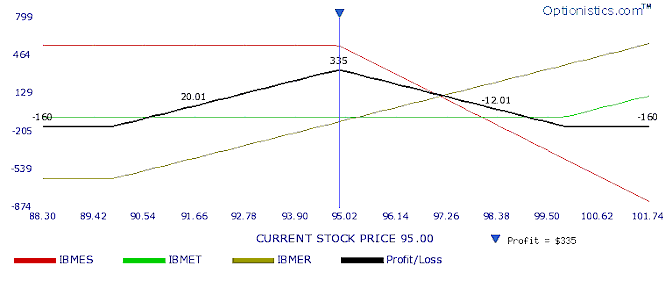Butterfly Spread
| Related Links |
|---|
 Butterfly Call Spreads Butterfly Call Spreads |
 Butterfly Put Spreads Butterfly Put Spreads |
| Calendar Straddles |
| Butterfly Diagonals |
| Double Diagonals |
| Iron Condor |
| Pointed Iron Condor |
The Butterfly Spread is a complex option strategy that consists of 3 legs. The center leg of a Butterfly Call Spread consists of two short near the money (NTM) calls, and the outer legs are 1 long in the money (ITM) call, and 1 long out of the money (OTM) call. The position is neutral, that is, the maximum profit is attained when the stock is at or near the center strike price. Losses are incurred when the underlying stock undergoes a significant price change.
The objective of the Butterfly trader is to profit by collecting premium from the short leg, while protecting against losses by buying the outer legs. The premium collected from the inner leg exceeds the premium paid for the outer legs, resulting in a net credit. The credit received at the time of the trade is the maximum profit of the trade. The maximum loss is net credit minus the greater of a) the OTM strike minus NTM and b) the NTM strike minus ITM.
 |
|
|
A Sample Butterfly Call Spread on IBM |
|
|
In the sample Butterfly Spread above, the center calls are at the money. The maximum profit is $335, which is slightly more than twice the maximum loss of $160. The trade is profitable as long as the price of IBM doesn't change by more than about $3. In theory, the maximum loss of a Butterfly Spread can be zero or even less than zero, resulting in a trade that cannot incur a loss. These trades can rarely be achieved in practice. Butterfly Spreads with a low ratio of maximum loss to maximum gain can be identified by the Butterfly Call and Butterfly Put Advanced Screeners. |
One approach to trading Butterfly Spreads is to enter trades where the potential for profit exceeds the potential for loss. In theory, executing many of these trades over time should result in a profit since a small number of big winners can offset the small losses on the losers. However, when the maximum loss is very small, the spread is also very small, and therefore the likelihood of profit diminishes
Another approach to trading Butterfly Spreads is to enter trades where the implied volatility is higher on the short leg and therefore relatviely more expensive than the long legs. The excess premium is collected at the time of the trade in the form of a larger net credit, and the spread (difference between the inner leg strike and the outer leg strikes), can be wide, increasing the range of profitability. Butterfly Spreads with disparities in implied volatility gain can be identified by the Butterfly Call and Butterfly Put Option Spread Screeners.

